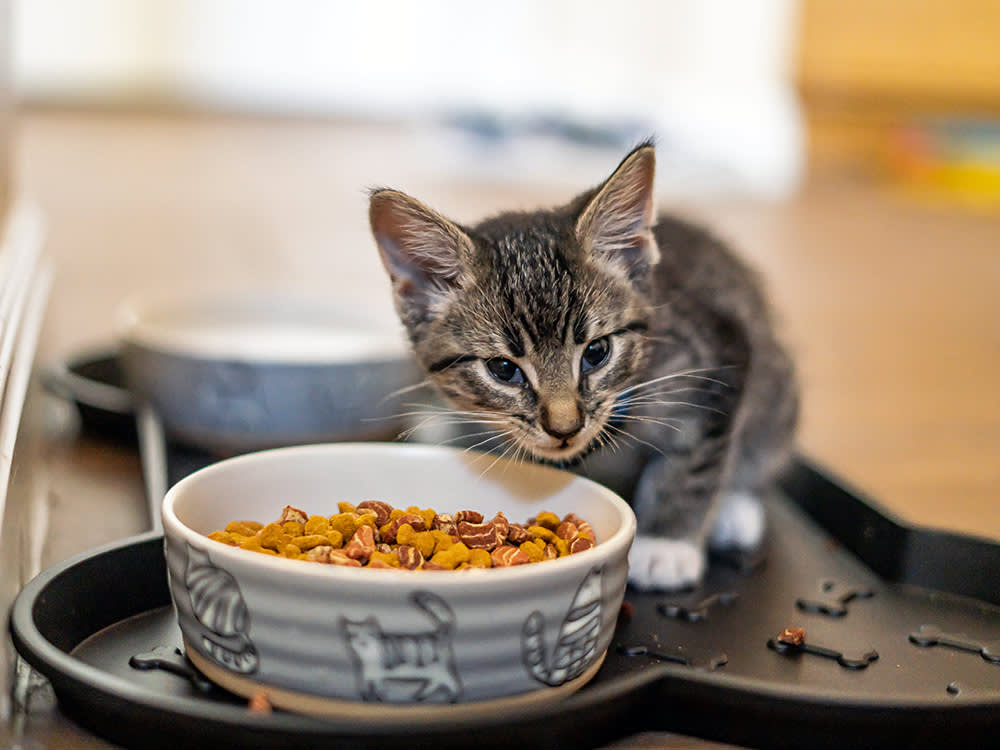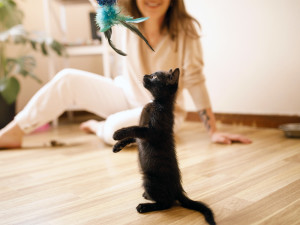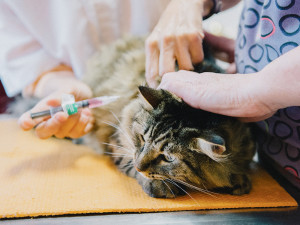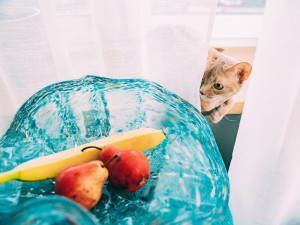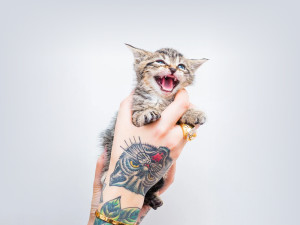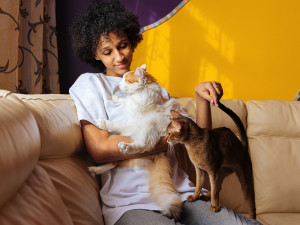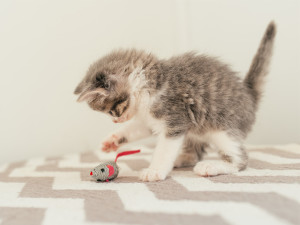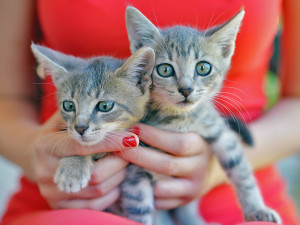Can a Kitten Eat Dry Food?
And the nutrients you should make sure they’re getting.
In This Article:
When Can Kittens Start Eating Dry Food? Benefits of Dry Food for Kittens How to Transition Kittens to New Food Best Dry Food for Kittens
Introducing your kitten to dry food is a personal choice, and if you do choose to do so, it’s important to introduce it at the right age. Most kittens start eating some solid food around four to six weeks old as they gradually wean off nursing, but they may not be able to handle the crunch of dry food right away.
Kittens typically start eating small amounts of solid food around four weeks old. But at that time, they do not have all of their teeth and need to start with a very mushy diet. As they grow and their teeth come in, they can handle more solid foods and even start to enjoy the satisfying crunch of dry food. Not all cats need to eat dry food, though, and there are benefits and drawbacks of a dry-food diet.
When can kittens start eating dry food?
Kittens can start eating dry food once they have a sturdy set of teeth to crunch hard kibble, and they are old enough for solid foods. In addition to making sure their chompers are ready, there are other important factors to consider:
The role of weaning and mother’s milk
Mother’s milk provides the most complete nutrition along with critical immune protection for newborn kittens. Kittens need to nurse exclusively until they are about three to four weeks old, and then they can start eating some solid foods. They will gradually nurse less over the next few weeks.
Most kittens stop nursing altogether by about six to eight weeks old, and this process is called weaning. It is ideal for them to have a slow, gradual weaning to ensure they are still getting all of their nutritional needs met as they learn to eat solid foods. It is also a very important developmental milestone for kittens to wean, and if they are weaned abruptly or too early, it can have detrimental effects on their health and behavior.
Young kittens who are found without a mother have to be bottle-fed instead of nursing, and they will need kitten-specific formula to drink until they can also be gradually weaned onto solid foods.
Typical age range for introducing dry food
Kittens are born toothless, and it takes about three to four weeks for their first baby teeth to begin growing in. This is the age where they can start eating some solid foods in addition to nursing. But again, they will need to eat very mushy food to start. Once they are about six weeks old, they should have all of their baby teeth, and this will make it easier for them to start eating hard foods.
Dry food can be introduced at this time, but you may have to soften it by soaking it in warm water first as your cat adjusts to the consistency. Over the first week or two, you can gradually soak the food less and less. It’s a good idea to offer a variety of foods at this age, including different flavors of both canned and dry food. This helps your cat adapt to variety and may prevent them from becoming picky eaters.
Developmental milestones
Understanding basic kitten development can help you strategize about when to introduce dry food too. The main milestones to keep in mind are that kittens will start eating some mushy solid foods around three to four weeks old, and this is when they start the gradual process of weaning.
Around this same time, their baby teeth start growing in and are usually all in by around 6 weeks old. Adult teeth start growing in at around 11 weeks old and are usually all in by 24 weeks, or six months old. Kittens grow rapidly from birth until about 12 months old. During this timeframe, it is critical that they have a nutrient-dense diet in abundance.
As most cats approach one year old, they have reached their adult size and they may start to gain weight if they consistently overeat. This is the age where you’ll want to start paying attention to their food portions, setting a consistent feeding schedule, and avoiding leaving food out at all times — known as free-feeding.
Age and weight guidelines
Kittens tend to have predictable growth during development, which can help to estimate their age if it is not exactly known. The general guideline is that kittens gain about one pound per month until they reach about 10 weeks old and then their weights may have more variability.
For example, a one-month old kitten should weigh about one pound, while a 10 week old kitten should weigh about two and a half pounds. You can use this guideline to figure out when to transition a kitten to some solid food and to ensure your kitten is gaining weight at the right pace. A kitten should weigh about one pound in order to start eating solids.
Breed-specific considerations
Most of these guidelines apply to cats of all breeds. One consideration to keep in mind is that large-breed cats like Maine Coons, Savannah cats, Norwegian Forest cats, Ragdolls, and Siberian cats may have a longer period of growth compared to the average domestic shorthair.
For these breeds, they may need access to a kitten-specific diet until they are closer to 18 months old to ensure they have reached their full size. Additionally, breeds that have smushed faces, like Persians and Exotic Shorthairs, may have misalignment of their teeth, making it more difficult for them to chew hard kibble. These cats should have access to canned food in addition to kibble.
Benefits of dry food for kittens
There are many factors to weigh when selecting a diet for your kitten. Brands, expense, flavors, and canned versus dry foods all need to be considered. Here are some reasons to consider adding dry food to your cat’s diet:
Convenience and cost-effectiveness
Dry food is dry, duh. But that means it has a long shelf life, and a large bag can last you a while if you store it properly. It tends to be less expensive than canned food, too. Because dry cat food can be left out for longer periods of time, it also means you can leave food available to your kitten even if you are not home. Young, rapidly growing kittens need to eat more frequently than adults so this can add to the convenience factor.
Dental health benefits
Because kibble is crunchy, it takes more effort to chew, and those chomping actions can help to remove tartar from the surface of your cat’s teeth. This may help to reduce certain kinds of dental disease especially if you also brush your cat’s teeth. However, cats tend to develop other kinds of dental disease, such as tooth resorption, that do not directly relate to tartar build-up, so eating dry food will not prevent all dental problems by any means.
Enrichment
Dry food can be left out at room temperature for longer than canned food, making it a good motivator for mental and physical enrichment. You can use their dry kibble inside of food puzzles and for interactive games without worrying about the food spoiling.
Nutrient-dense formulas for growth and development
When comparing dry food to canned food, canned food contains more water. As a result, cats may get full more quickly when eating canned food. Kittens may be able to eat more dry food in one sitting, and it may help them to stay full a bit longer since it takes longer to break down in the digestive tract.
This can be beneficial in younger, active kittens who have small stomachs and cannot eat a large amount of food in one sitting. This can help stretch the time between feedings and keep them full a bit longer. Whether you choose dry food, canned food, or both, it is very important that you select a formulation intended for kittens that is labeled for growth and development. This ensures that the food will provide all the nutrients for a growing kitten.
Variety
Introducing kittens to a variety of foods is a good way to reduce the chances of pickiness later on. Sometimes, as cats get older, they may have health problems that require them to eat a new diet. If they are used to foods with different flavors and textures, it will be easier to change their diet when needed. Whether you choose to feed your cat canned food, dry food or both in the long-run, it is a good idea to introduce them to both during these early months.
Drawbacks of dry food
While there are many compelling reasons to feed your cat dry food, there are also a few important drawbacks to consider.
Water content
Dry food has a much lower water content than wet food. This can be meaningful for cats, because most do not drink much water, and they tend to get the bulk of their hydration from their food. As they get older, many cats develop conditions that may be helped by adding water to their diet, including urinary problems, obesity, and/or kidney disease. These cats often need to eat only canned food, so it is helpful if they are already accustomed to the taste and texture.
Weight control
Once cats reach their full adult size and stop growing, their metabolic needs change, and they are more at risk for gaining weight if they overeat. Indoor cats also tend to be quite inactive and the combination of overeating with a sedentary lifestyle puts them at especially high risk for obesity.
Many cats tend to overeat their dry food because it has less water content, so they fill up more slowly. This is especially common for cats who are free-fed, meaning they always have access to dry food, and it is not measured out in a recommended portion size. If you do plan to feed your cat dry food, always measure out their serving based on the recommendations of the bag and limit their portions to that amount.
Variety
Once again, limiting your cat’s exposure to only one kind of food, one flavor of food, or one texture may put them at risk for picky eating as they get older. Take advantage of their curiosity at this age and introduce them to many different options including canned foods.
How to transition kittens to new food
Any time you are introducing a new food, whether you have a kitten or an adult cat, it is important to do so slowly for a number of reasons.
Gradual introduction
A gradual introduction allows time for your cat to adjust to new flavors and textures while also physically adjusting to a new diet. Because many cats tend to eat the same food every day, they may have trouble digesting a new food, and this can lead to digestive upset including poor appetite, vomiting, and/or diarrhea.
Mixing the old food with the new food
A good rule of thumb to follow is to mix the food your cat is used to eating with increasing amounts of the new food over the course of three to five days. This allows a gradual introduction so their bodies have time to adjust to a new diet.
If you have a very young kitten that you are transitioning from bottle-feeding to solid foods, you can also mix kitten formula with a small amount of mushy cat food in this same kind of gradual transition.
Monitoring acceptance and adjusting ratios
As you are slowly increasing the proportion of new food in your cat’s diet, be sure to monitor your cat’s enthusiasm, appetite, and to look for any signs of an adverse reaction. If your cat is not eating with gusto, avoiding eating altogether, or having physical reactions like vomiting, diarrhea, or hives, you may need to take a step back.
Try a more gradual introduction, or try a completely different option, especially in the case of a possible allergic reaction. Be sure to speak with your vet if you are concerned about a possible allergic reaction, too.
Best dry food for kittens
When selecting foods for your kitten, be sure to keep the following in mind:
Age-specific formulas
This is the most important guideline for all kitten diets; be sure that the food you purchase is labeled as a complete- -and-balanced diet for daily nutrition and that the diet is specifically formulated for kittens. Some foods may say they are appropriate for all life stages, while others may be specific for growth stages or kittens. Any of these would be fine for kittens, but they should not eat a food that is only formulated for adult cats.
They also should not eat a food that is meant to be more of a treat or snack and is not balanced as a daily diet. These guidelines ensure that a growing kitten gets all of the nutrients they need in the proper proportions for their growth and development. It is important that once they reach about one year old, however, that they transition to a diet that is appropriate for adult cats so that they do not continue on a high-calorie kitten diet that may lead to weight gain.
Quality protein sources and balanced nutrients
Selecting a high quality diet with the best ingredients is also important to your kitten’s health. But it can be tricky to interpret ingredient labels and nutrition information for pet food. Cats are especially unique in that they are obligate carnivores and their nutritional requirements are very different from ours.
This means that while we may consider organ meat and certain meat byproducts to be less desirable, they may be an excellent source of specific nutrients your kitten really needs. Be sure to consult your vet for good recommendations on the best dry food for your kitten.
Kibble size
This may be an obvious one, but tiny kitten mouths need tiny, bite-sized kibble. Your kitten may have a hearty appetite and want to gobble down whatever food you offer, but if they cannot adequately chew up their kibble, they may be more at risk for indigestion, vomiting, and gas. Be sure to find kibble that is small enough for your kitten to manage, or soak larger kibble in water to soften them a bit and make it easier for your kitten to chew them up.
FAQs (People also ask):
When can a kitten eat a fully dry-food diet?
Kittens can eat a fully dry-food diet once they are completely weaned from nursing and have a full set of sturdy teeth. This is usually around six to eight weeks old, but they may need their kibble softened with water.
Do cat foods for sensitive stomachs really help?
Most over-the-counter foods are not going to help if your cat has a problem like vomiting, diarrhea, or weight loss. They need to be seen by a vet first and if they have a specific medical problem that requires a diet change, they will likely need a prescription diet formulated to treat that specific problem.
What is the best dry food for kittens?
The best dry foods will be specifically formulated for growing kittens and will have high quality ingredients.
